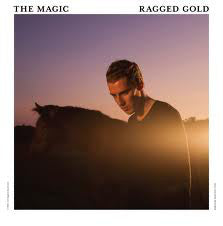The Magic - Ragged Gold
The Magic - Ragged Gold
Couldn't load pickup availability
Debut album from The Magic, released on 180g vinyl 2012
"It’s rare one comes across a genuinely ground-breaking album. Most collections owe something to that which has gone before; indeed, the theory that all modern popular music can trace its roots back to Deep South blues is as widely accepted as social theory can be. But it’s just as uncommon to find one that wears its influences quite blatantly on its sleeve, or in the case of ‘Ragged Gold’ by Canadians The Magic, as metaphorical sewn-on band patches on the back of a bleached denim jacket.
Lead-off single ‘Mr. Hollywood’, with its bleeps, bangles and glossy harmonies, has a backing track straight out of a DX-7 demo ROM, overlaid with that kind of clean, palm-muted guitar that sold so many chorus pedals thirty years ago. Effortlessly evoking bright white yachts cutting through sparkling Mediterranean water, populated by men and women in skimpy Speedos, who end up in a glossy, chromed nightclub with a neon-lit dance floor; references to Coupes de Ville and pink champagne only serve to amplify the general ambience of glamorous excess. There’s stunning sequenced bleeps behind the main arrangement – overall, a masterclass in styling and justly chosen as ambassador for the album.
Continuing the ’80s theme, opening track ‘Lightning Strikes’ leaves the listener in no doubt as to what is to come, with its enormous, mid-tempo chorus, primarily arranged with synth washes, synth bass, and – yes, you guessed it – wailing synth lead notes. Only a pair of pulsing rhythm guitars saves the track from being entirely electronically-arranged. ‘Night School’ is a more threatening, uptempo white-funk workout, which wears its flyaway bleached blonde fringe unashamedly, stuttering across the stage with peacock pride. Vocal duties are shared between brothers Geordie and Evan Gordon, with the silky vocals of Sylvie Smith as a counterpoint. In fact, Sylvie’s voice is just as important as the boys’, taking lead duties on the jaunty, be-saxophoned ‘Call Me Up’, and providing useful harmonic balance. Indeed, the saxophones are an important part of the latter half of the album, which moves away from the 80s and opens up a whole new cupboard of influences, this time primarily of the previous decade. Like a fine wine, there’s a conflation of a number of individually delicious flavours into one congruent whole – one can spot Chic, 10cc, Quincy Jones, Pet Shop Boys; deeper down even New Order and contemporary revivalists like Chromeo and College. Quite a melting pot, but due to the careful rein on arrangements, nothing feels overblown. The game of spot-the-influence can actually be a hindrance to the music itself – a fun distraction from enjoying the resulting blend.
This is a record that’s supremely self-confident in its source material, refreshingly honest about its stylistic influences, yet simultaneously deeply original – all the pieces are arranged in new ways, whilst still sounding comfortingly familiar. Heavy retro influences abound without descending into parody. There’s disco in the square-wave synths, ’70s AOR in the electric piano and saxophones, shedloads of funk in the bass, early ’80s flouncing pop in the cheap drum machines and archly-delivered male vocals, with the occasional flash of contemporary hip-hop sensibility. Arrangements are architecturally precise, modernist constructs – music by which to ascend the lift in a van der Rohe skyscraper, marvelling at the clean lines and glossy surfaces.
The Magic have done a good job on their debut. Whether they can transcend their influences and develop their sound into something more personally reflective remains to be seen. But to make a debut record that works as both a historical reference point and enjoyably contemporary listen is no mean feat… it’s The Magic."
There Goes The Fear - 8/10


